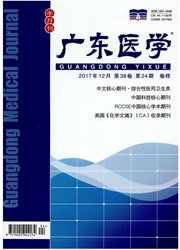

 中文摘要:
中文摘要:
目的:探讨纳米金(gold nanoparticles,GNPs)对人肝癌阿霉素(adriamycin,ADM)耐药细胞株HepG2/ADM的阿霉素耐药性的逆转作用及其可能机制。方法:MTT比色法检测GNPs对人肝癌细胞株HepG2及其耐药细胞株HepG2/ADM对不同浓度 ADM 耐药性的影响;流式细胞术检测 GNPs 处理后 ADM (2 mg/L )对HepG2/ADM细胞凋亡的影响;紫外分光光度计检测GNPs处理后HepG2/ADM细胞内ADM的药物浓度;谷胱甘肽( GSH)检测试剂盒( DTNB法)检测GNPs处理后HepG2/ADM细胞GSH的含量。结果:GNPs处理前HepG2和HepG2/ADM细胞对不同浓度ADM的半数抑制浓度分别为:(9.16±2.03)mg/L、(29.46±1.73)mg/L,耐药倍数为3.22;GNPs处理后HepG2/ADM 细胞对不同浓度ADM的半数抑制浓度为(15.18±0.85)mg/L,逆转指数为1.95。GNPs+ADM组HepG2/ADM的细胞凋亡率明显高于单独ADM组(P<0.05)。 HepG2/ADM组细胞内的ADM含量低于HepG2组细胞内的ADM含量( P<0.01);GNPs处理后HepG2/ADM细胞内的ADM含量较处理前明显增加(P<0.01)。 HepG2/ADM组细胞内GSH含量高于HepG2组(P<0.01);GNPs处理后HepG2/ADM细胞内的GSH含量较处理前明显降低( P<0.05)。结论:纳米金具有逆转耐药肝癌细胞对阿霉素耐药性的作用,并且可以降低细胞内GSH含量及增加胞内化疗药物浓度。
 英文摘要:
英文摘要:
AIM:To investigate whether gold nanoparticles (GNPs) reverses adriamycin (ADM), resistance of human hepatocellular carcinoma drug-resistant cell line HepG2/ADM and to explore the potential mechanism.METH-ODS:The sensitivities of HepG2 cells and HepG2/ADM cells to ADM were tested by MTT assay before and after GNPs pretreatment.The apoptotic rate was examined by flow cytometry.The concentration of ADM in HepG2/ADM or HepG2 cells was determined by ultraviolet-visible spectrophotometer .The content of glutathione ( GSH ) in HepG2/ADM or HepG2 cells by DTNB method.RESULTS:The half maximal inhibitory concentrations ( IC50 ) of ADM for HepG2/ADM cells were(29.46 ±1.73) mg/L and (15.18 ±0.85) mg/L before and after GNPs pretreatment,respectively.The IC50 of ADM for HepG2 cells was (9.16 ±2.03) mg/L before pretreatment.The apoptotic rate in GNPs+ADM group was higher than that in ADM group ( P〈0.05 ) .The concentration of ADM in HepG2/ADM group was lower than that in HepG2 group (P〈0.01).After GNPs pretreatment, the concentration of ADM in HepG2/ADM cells was higher than that before pretreatment.The content of GSH in HepG2/ADM group was higher than that in HepG2 group (P〈0.01).After GNPs pretreatment, the content of GSH in the HepG2/ADM cells was lower than that before pretreatment.CONCLUSION:Gold nanoparticles can reverse ADM resistance of human hepatocellular carcinoma drug-resistant cell line HepG2/ADM, 〈br〉 reduce the content of GSH and increase the concentration of ADM in HepG2/ADM cells.
 同期刊论文项目
同期刊论文项目
 同项目期刊论文
同项目期刊论文
 期刊信息
期刊信息
